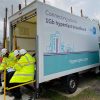Draft Strategy for £5bn UK Gigabit Broadband Rollout Published UPDATE

The Government has today published the draft procurement strategy for their new £5bn Gigabit Broadband Programme (F20), which is a consultation on their plan to ensure that gigabit-capable networks reach a “minimum” of 85% UK coverage by the end of 2025 (before getting “as close to 100% as possible” thereafter).
The Government has initially only released £1.2bn of this funding for the next 4 years. But they’ve today said that the commitment to invest £5bn “still stands” and they “will accelerate this investment if industry can demonstrate it has the capacity to deliver further and faster.” In any case, they won’t actually need much of this until the build starts, which is likely to be around end of 2021 or early 2022 (assuming no delays and that’s a big assumption).

At present it’s often predicted that commercial deployments of gigabit-capable broadband networks alone will push coverage to over 70% of premises by the end of 2025 (some expect c.80%), which seems viable. However a lack of clarity on key issues, such as overbuild between rivals, a shortage of skilled engineers, post-2020 state aid rules (Brexit negotiations) and uncertainty over long-term rollout plans, make it difficult to be certain.
Advertisement
By comparison the new programme, which is more centralised and will be overseen by the Building Digital UK team within DCMS, is focused upon tackling the final 20% of hardest to reach premises – using an outside-in build strategy (i.e. starting in rural areas first). We’ve already done a summary of all this and the publication of today’s Draft Procurement Strategy confirms much of that, while also adding some extra details.
Summary of Key Points from the Strategy
— The approach in England will be centralised, although the Government still claims to be working “closely with the Devolved Administrations in Scotland, Wales and Northern Ireland from early 2021 to develop plans to complement these contracts and extend gigabit coverage across the UK” (i.e. we don’t yet know how the funding / programme will work for those administrations).
— Contracts are likely to be issued for lots of different clusters of premises (bundles) – some for larger areas and others for smaller ones. The consultation anticipates up to 26 large regions of England that are most likely to attract commercial investment, but require subsidy to reach the hardest 40,000 to 80,000 premises in each area.
The government expects larger broadband suppliers, including challengers to incumbents, to bid for these areas (since it favours their economies of scale) and will prioritise people with slower speeds (i.e. sub-30Mbps but NOT to the exclusion of all else). This includes areas of Northumberland, Yorkshire, Lancashire, Shropshire, Worcerstershire, Gloucestershire, Somerset, Oxfordshire, Berkshire, Devon, Dorset, Sussex, Norfolk, Suffolk, Essex, Buckinghamshire, Cambridgeshire, Northamptonshire, Shropshire, Staffordshire, Derbyshire and Lincolnshire.
— Contracts will also be issued for lots of smaller contracts to connect around 1,000 to 8,000 premises, to stimulate competition across a wider range of small, medium-sized and rural specialist telecoms providers and help them to scale-up. This could include areas of Cumbria, Westmoreland, Yorkshire, Devon, Somerset, Dorset, Herefordshire, Lincolnshire, Oxfordshire, Kent and Sussex, depending on where these providers wish to compete.
— DCMS / BDUK are also exploring how to make available a small number of contracts covering very large areas that are the least commercially attractive to build in. “This would help make sure that no areas are left behind – even those where there is a limited prospect of competition,” although they’ve yet to finalise the proposal for this.
— The Government has confirmed their worst kept secret, which is that they will look to extend the existing Rural Gigabit Voucher Scheme from April 2021 onwards. Obviously, this will need to be done in a way that complements rather than competes with the aforementioned contracts (larger value vouchers are a strong possibility too) and that forms part of today’s consultation.
— The existing approach adopted by the Local Full Fibre Networks (LFFN) programme, where public money is used to help build Dark Fibre to connect public and community buildings (e.g. council houses, schools, libraries and GP surgeries) will continue. Such networks can then be harnessed by the commercial sector to help extend FTTP broadband into surrounding homes and businesses etc.
Assuming all goes well then the new procurements for gigabit infrastructure, which will be handled through a Dynamic Purchasing System (DPS), are set to begin in Spring 2021 (around April). Big operators like Openreach (BT) will naturally take part, but we also expect KCOM, Cityfibre and possibly even Virgin Media’s new network sibling (Liberty Networks) to also take part, along with lots of other alternative networks (AltNets).
In theory the rollout could help to extend coverage to a further 5-6 million premises, which would be similar to what the original BDUK Superfast Broadband Programme (SFBB) achieved, albeit with significantly faster connectivity.
Matt Warman, UK Minister for Digital Infrastructure, said:
“Today we’ve set out our bold programme of national infrastructure projects to future-proof the UK’s internet networks so we can build back better from coronavirus and create new jobs and economic opportunities.
We will begin these procurements rapidly so broadband providers big and small can move quickly to get the job done and level up communities with this much faster, next generation broadband.”
Clive Selley, CEO of Openreach, said:
“This is a big step towards levelling-up the UK. Whilst private investment will pay for the vast majority of broadband upgrades across the country, we’re keen to help Government reach more isolated communities. At Openreach, we’ve got the biggest and best team of engineers in the industry, with unrivalled experience connecting rural homes and a huge ambition to match.
We’ve all seen the importance of having decent broadband this year, so we’re keen to crack-on and do the lion’s share. We’re also convinced that Full Fibre technology can be a huge catalyst for the UK’s future prosperity so there’s no time to delay.”
Greg Mesch, CEO of CityFibre, said:
“We are pleased that Government is committed to making this a truly competitive process. This will deliver value for money, unlock additional private investment and speed up rollout. At CityFibre, our UK-wide full fibre rollout to 8 million premises is well underway. We are creating up to 10,000 new jobs, and as we enter our second decade, we are ideally placed to deliver this vital infrastructure across the UK, ensuring nowhere is left behind.”
At the time of writing we haven’t yet seen the consultation document itself, but we note that the Government’s announcement states that those covered will see their speeds “rocket from less than 30 megabits per second to more than 1000, or one gigabit,” but there is some confusion here. Firstly, our understanding is that the connection only needs to be classed as “gigabit-capable” and the end-user still has freedom to choose a slower plan (i.e. they aren’t forced to take 1Gbps).
Advertisement
Furthermore, documents released in July 2020 revealed that BDUK appeared likely (i.e. not finalised) to require a “normally available” download speed of at least 500Mbps and uploads of 200Mbps, which in “limited circumstances” may fall to at least 50Mbps download and 20Mbps upload (here).
The above speeds seem more realistic since they aren’t mandating uncontended leased lines for homes (saying 500Mbps is more about defining real-world capability on residential focused networks with shared capacity etc.) and, in any case, most rural homes would hardly moan at such speeds. Nevertheless, some people may be confused by anything that seems like a dilution of “gigabit” performance.
The new approach, with its many different sized clusters (bundles), is also quite complex and we think it will be crucial for there to be plenty of public transparency with respect to coverage plans, costs and clawback for each awarded contract. The prior SFBB programme did a reasonable job of this, but some local authorities were much better at communicating the details than others. Hopefully the centralised approach will do better.
Finally, we should remind readers that the Government seems keen to adopt a technologically neutral approach to delivery. Previous updates have talked about FTTP, DOCSIS 3.1 Hybrid Fibre Coax and 5G or fixed wireless broadband as all being able to play a part. We should add that the mobile variant of 5G is unlikely to deliver gigabit speeds to many rural areas – such rollouts tend to deliver slower speeds as operators prefer lower frequencies to maximise wide coverage (cost effective but not enough spectrum for the best speeds).
Advertisement
Finally, it’s worth noting how the Government have already warned (here) that they consider the “final 1%” of premises “could be prohibitively expensive to reach” via even their gigabit programme (the same sort of area that their 10Mbps USO was supposed to help and this has suffered problems). One recent forecast predicted that the gigabit coverage would most likely reach 98%+ by 2030 (here).
UPDATE 3:09pm
The following map gives a good idea of how the new procurement boundaries for intervention will look across England, albeit not finalised.

Mark is a professional technology writer, IT consultant and computer engineer from Dorset (England), he also founded ISPreview in 1999 and enjoys analysing the latest telecoms and broadband developments. Find me on X (Twitter), Mastodon, Facebook, BlueSky, Threads.net and Linkedin.
« Full Fibre Ltd to Rollout FTTP Broadband to 500k UK Premises























































My contention remains that the term “Gigabit Capable” may be as misleading to the general public as other terms that have been used in the past. Clearly the hard part is getting fibre out to all premises so we have a high performance/reliable medium and yes we can add upgraded kit later to increase the speed capacity in years to come. But the reality is that the current rollout designs (OR and Altnet) can only provide a small percentage with Gigabit Speeds (less overhead) and that the standard GPON 32:1 ratio to OLT can only deliver a finite shared capacity.
Where overbuild occurs then the competing networks may be at a lower utilisation and therefore overall capacity remains high however where there is a single FTTP network the capacity is unlikely to support gigabit products without degradation, hence the low stated service levels. There would have to be future waves of investment to upgrade later and the investment for that is neither planned or committed. The Government would argue that as consumers request higher capacity the market will respond but the industry will be fully focused on rollout for the next 7 years.
So my view is that if people are looking for Gigabit they will be disappointed and a much more honest term for now would be “Ultrafast Capable” as it more reflects the what the vast majority will actually be able to achieve.
Ok what you say makes sense.
But the reality is that ATM a home needs say 200/100 for WFH and schooling.
If you went from wet string provisioned ADSL to 100/50 baseline you would be in heaven.
And as you rightly point out FTTP is fully upgradable.
Yes I am not saying most consumers need it now or are likely to need it. It is about how it will be Marketed and our Ofcom/Government being honest. Knowing the latter may be impossible.
Bear in mind “gigabit capable” could include a wireless solution with a fair usage policy of a few GB a month.
As usual the devil is in the detail and no doubt we’ll see the usual gamut of half-solutions like satellite & wireless rather than the real deal with unlimited usage.
Rural Digital Apartheid has clearly become official government policy!
I realise this is probably quite selfish / whiny of me, but all this talk of “sub-30mbps” makes me think that our 34mbps downstream speed here in Altrincham is going to mean we don’t see any improvement before 2030.
Two people working from home over three laptops, with both on frequent video conferences and me needing to download and upload large quantities of data – it isn’t ideal and we do see problems.
Got a letter the other day about BTnet Express which interested me until I found out that speeds are “up to 50mbps” and would cost £97 per month excluding VAT…
VM don’t cover here either. It is frustrating to have such a lack of options and not really any hope for the next decade.
I’ve spoken to DCMS before about this and, while they will priorities sub-30Mbps areas, it is most definitely not to the exclusion of all else. As usual the key is whether or not a new network (e.g. FTTP) delivers a step change over existing solutions (significant performance improvement) and for you it probably would.
The document does make clear it is more than 30Mbps – so it is in-fill, although the numbers 15 regional contracts and 30 small ones point to more than a 1m premises where as the outstanding uncontracted <30Mbps is less than 500k premises.
BDUK should make it clear if they want this process to overbuild what was recently subsidised.
I think English counties will kick themselves for not making better use of underspends and clawback.- see WPQ 126868
The 2025 fantasy has been abandoned. I hope the uncontracted work in England is not lost to an unproven process where the spending review is only for 1 year, the remaining three years will need to be re-presented.
Thanks Mark, that certainly sounds promising!
If the FTTP ended up being someone like Hyperoptic (might not be the right fit but just as an example), would I need to move from my current ISP Aquiss to get FTTP?
Had the feeling that unless it is OpenReach FTTP it won’t be available via my current ISP, which would be a massive shame as I never want to move away from them!
Yes you would have to move.
Awuiss don’t wholesale from Hyperoptic.
I can get 1000/110 but I don’t want or need it right now. i get by on 26/4 just fine. But it’s nice to know it’s there and it’s not out of reach money wise.
I live 3300 metres from my nearest exchange. My copper line from this box gives me 10mbps down. I got quoted £6700 per household for a 27 home Openreach community fibre project (non-starter). I don’t live in a built up area so a 5g antenna won’t be nearby. I’m well frustrated I can tell you.
Wow, puts my 34bmps into perspective, hope you get something soon.
Perhaps Starlink would be a great option for you. Satellite low latency speeds between 50-150Mb. It’s £89 a month though…
With this clustered or bundled approach to rural contracts I guess it is a bit of a lottery for the consumer ? As I see it, without close regulation and an effective Common Wholesale Platform, rural consumers could end up being stuck as a captive audience with the choice of a single ISP.
I dont think so… One of the requirements of the Outside In approach is the network builder needs to allow 3rd party access (wholesale). This means customers will be able to switch provider.
Even with the requirement to allow 3rd party access, wouldn’t there still be the concern that without a CWP the larger ISP’s just wouldn’t bother entering into agreements with the smaller network builders ( thereby still limiting consumer choice) ?
“We’ve all seen the importance of having decent broadband this year, so we’re keen to crack-on and do the lion’s share”. A direct quote from the CEO of Openreach.
Im sorry, I was under the impression that
a) Outside In was a way for Altnets to be involved in full fibre delivery and
b) These Outside In projects hadn’t actually been awarded yet
Does Clive Selley already know something we dont?
Just reality, To win the bids companies will have to sign up to timescales which will include % of premises, equipment and resource (currently running at 160k per month, recruiting more and can train over 4000 new people a year). Only Cityfibre currently appear to have significant resourcing plans.
To get the price down it will inevitably be where each provider already has, or will have, back haul. OR are naturally in a good position for this and can extend current FF areas, BDUK, WG and R100. Other providers like Cityfibre will pick up their LNNF and existing presence.
OR have only forecast investment for 20m by 2027 so that still leaves 10m for others. There will be continued overbuild in some commercial areas but with the carrot of subsidy and possibly high utilisation FTTP providers will divert their focus to this.
Whoever the chosen provider is I hope it comes with an obligation to cover all premises in the selected areas (within the subsidy limit per premises), we don’t want people left in isolated DSL islands.
We would like to get 24Mbs on FTTC, however we are part of the ‘cursed 5%’, paying for the lucky 95%.
We just hope the County Council do not get involved as they really screwed up.
4G, only two bands available.
Requirements:
The solution components should be clearly documented, along with suitable design approaches and operational procedures that are consistent with industry practice.
Gives solid access network designs only.
The solution should be upgradeable and extensible
Does not exclude non FTTP but it would be hard to demonstrate this.
At least one Retail Service Provider (RSP) should be expected to resell the wholesale products to offer services to end users
Disappointing as the user may be locked long term regardless of the ISP service. My view is that they should support an open wholesale approach.
The wholesale access products should have appropriate prices, set with reference to appropriate price benchmarks.
No doubt to protect consumers but what is to stop them charging more going forward.
The supplier has processes in place for operating the network e.g. order handling, fault management
There must be a robust build approach and transparent timetable
To address past issues where providers have failed timescales.
There must be a risk register to document the risks that may affect the timetable
All premises identified by the Authority in the Intervention Area must be provided with
– Gigabit Capable Connectivity with a normally available download speed of at least 500Mbps and upload speed of 200Mbps
– In limited circumstances, Ultrafast Capable Connectivity with a normally available download speed of at least 50Mbps and 20Mbps upload
Disappointed with the latter as it infers perpetuating long term disadvantaged premises, how can this ever be “Gigabit Capable” without significant future investment. However the “All Premises” statement is good to see.
All premises must be designed and proven to have no excess construction charges to be counted as part of the Coverage
Ensures suppliers do not apply excessive Installation charges.
So I live in Hertfordshire and get 10mb but my county is not listed ! . I guess the issue is 99% of the county is fine but the village I live in is not
I checked my area, two towns with 5km of each other, and we are in the grey zone, that said we are on the Market Town list
which I understand is still under consultation with Ofcom re roll-out and funding.
A decision is due in March 2021 AFAIK.
Your location may be on this project
https://www.ispreview.co.uk/index.php/2020/07/ofcom-tweak-uk-market-definitions-to-help-bts-rural-fibre-rollout.html
or
https://www.ispreview.co.uk/index.php/2020/01/openreach-add-227-rural-uk-areas-to-fttp-broadband-rollout.html
Annoyingly fibre is at the end of the street, as a provision to new builds and fttc to a neighbouring village.
Is it possible to have a more detailed map with the ability to zoom in?